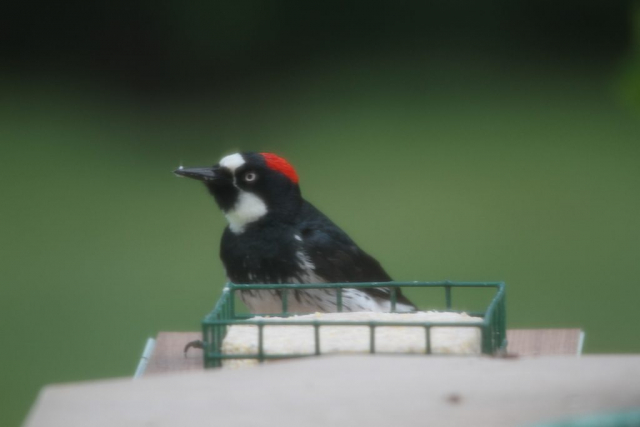Melanerpes formicivorus
Status: Rare casual summer visitor.
Documentation: Photograph: 19 May 1996 Chambers, Holt Co (Brogie 1997).
Taxonomy: Seven subspecies are recognized (AviList 2025), five from Mexico through South America, and two in North America north of Mexico: bairdi of Oregon south to northern Baja California and formicivorus of southwestern US to southeast Mexico.
The distribution of records on and near the Great Plains suggests a southwestern US provenance (see Comments).
Summer: There are three records:
19-22 May 1996, at a feeder stocked with oranges at Chambers, Holt Co (Brogie 1997)
15-16 Jun 2013 Hayes Co (Brogie 2014)
7 Oct 2012, at a feeder in Blair, Washington Co (Brogie 2014).
Comments: This essentially non-migratory species occurs in west Texas, New Mexico, Arizona, and California. According to Koenig et al (2020), it is “A good colonizer, regularly found outside its normal range sometimes far from breeding habitat, although usually within 200 km of known populations”, and “Widespread mast-crop failure can lead to permanent disappearance of a large proportion of the population and may lead to a “flight year” in which birds are found in habitats that are normally unsuitable, including deserts and open grasslands”. A population in southeastern Arizona is the only regularly migrant population (Koenig et al 2020), and spring overshoot migrants likely provide the northward records into the Front Range of Colorado and into Nebraska, Iowa, Minnesota and North Dakota. Of about 25 records on the Front Range, half are for Apr-Jul, and three of the six records farther north and east of the Great Plains are for Jun-Jul (eBird.org, accessed Oct 2023). Fall and winter records are fewer, most in Colorado. There are no records for Kansas or South Dakota (Thompson et al 2011; Tallman et al 2002; eBird.org, accessed Oct 2023), supporting Great Plains vagrancy being derived from Front Range visitors. The six records for the northern Great Plains are all in different years, indicating random vagrancy: North Dakota in Jun, Minnesota in Jul and Nov, Iowa in Sep, and Nebraska in May-Jun and Oct (eBird.org, accessed Oct 2023).
Images
Literature Cited
AviList Core Team, 2025. AviList: The Global Avian Checklist, v2025. https://doi.org/10.2173/avilist.v2025.
Brogie, M.A. 1997. 1996 (Eighth) Report of the NOU Records Committee. NBR 65: 115-126.
Brogie, M.A. 2014. 2013 (25th) Report of the NOU Records Committee. NBR 82: 131-146.
Koenig, W.D., E.L. Walters, P.B. Stacey, M.T. Stanback, and R.L. Mumme. 2020. Acorn Woodpecker (Melanerpes formicivorus), version 1.0. In Birds of the World (P. G. Rodewald and B. K. Keeney, Editors). Cornell Lab of Ornithology, Ithaca, NY, USA. https://doi.org/10.2173/bow.acowoo.01.
Tallman, D.A., Swanson, D.L., and J.S. Palmer. 2002. Birds of South Dakota. Midstates/Quality Quick Print, Aberdeen, South Dakota, USA.
Thompson, M.C., C.A. Ely, B. Gress, C. Otte, S.T. Patti, D. Seibel, and E.A. Young. 2011. Birds of Kansas. University Press of Kansas, Lawrence, Kansas, USA.
Recommended Citation
Silcock, W.R., and J.G. Jorgensen. 2025. Acorn Woodpecker (Melanerpes formicivorus). In Birds of Nebraska — Online. www.BirdsofNebraska.org
Birds of Nebraska – Online
Updated 14 Jul 2025

